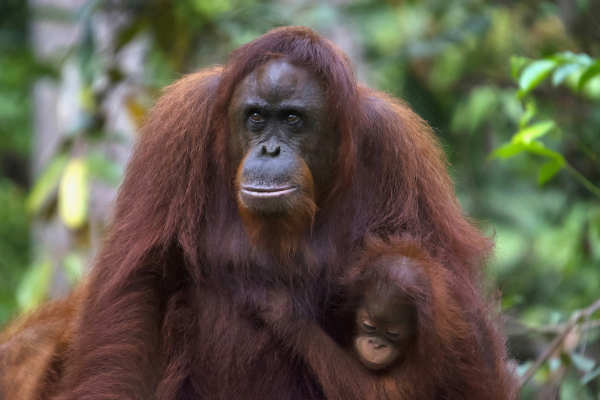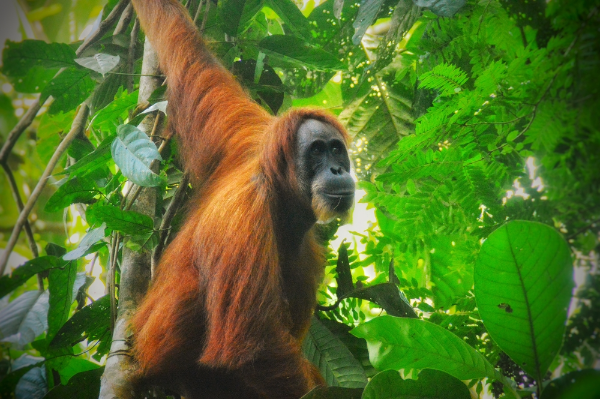Sumatran orangutans are one of the most critically endangered species on the planet. There are only an estimated 6,500-7,500 Sumatran orangutans remaining in the wild, making them one of the most endangered primates in the world. These animals are being threatened by habitat loss and hunting, and they desperately need our help. learn more about these fascinating animals and how you can help protect them.

Sumatran Orangutan Description
The Sumatran orangutan is one of the two species of orangutans. It is native to the island of Sumatra in Indonesia. Sumatran orangutans are red-haired, with a shaggy coat that helps to keep them warm in the cool forest environment. They are slim and have long arms, which they use to swing from tree to tree. Sumatran orangutans are also very intelligent, and have been known to use tools to help them with tasks such as opening coconuts. Sadly, Sumatran orangutans are now critically endangered, due to habitat loss and illegal hunting. There are thought to be less than 7,000 Sumatran orangutans left in the wild, making them one of the most endangered animals on Earth.
Sumatran Orangutan Habitat
Sumatran orangutans are an endangered species of great ape native to the Indonesian island of Sumatra. The Sumatran orangutan is one of only two species of orangutan, the other being the Bornean orangutan. Together, these two species make up the genus Pongo. Sumatran orangutans are currently only found in the wild in the north-western part of Sumatra, although they were once more widespread across the island. The estimated population of Sumatran orangutans in the wild is between 3,400 and 5,000 individuals. The primary threat to Sumatran orangutans is loss of habitat due to deforestation for palm oil plantations, although they are also hunted for bushmeat and their body parts are used in traditional medicine. Sumatran orangutans are very different in appearance from their Bornean cousins. They are shorter, with longer hair and a more reddish hue. They also have distinctive cheek pads known as flanges. The Sumatran orangutan is an intelligent and curious creature with a complex social life.
Sumatran Orangutan Diet
Sumatran orangutans are one of the most endangered species of apes, and their diet is a major contributor to their decline. Sumatran orangutans are native to the island of Sumatra, and their diet is primarily composed of fruits, leaves, and insects. However, habitat loss and deforestation have led to a decline in the availability of Sumatran orangutans’ preferred food sources. In response to this, Sumatran orangutans have been known to eat a variety of other foods, including bark, twigs, and even bird eggs. However, these alternative food sources are often lower in nutrients and calories, which can lead to health problems for Sumatran orangutans. Additionally, the Sumatran orangutan’s diet is further strained by competition from other animals, such as pigs and deer. As a result of these factors, the Sumatran orangutan’s diet is a major factor in its decline.
Sumatran Orangutan Size
Sumatran orangutans are the largest species of orangutan, and they are also the largest arboreal animals in the world. Adult males can grow to be over 7 feet tall and weigh more than 300 pounds. Females are smaller, but they still typically weigh over 200 pounds. Sumatran orangutans are found only on the Indonesian island of Sumatra, where they live in rainforests and mangrove forests. They are endangered due to habitat loss and hunting, and there are thought to be fewer than 7,000 Sumatran orangutans remaining in the wild.
Sumatran Orangutan Lifespan
Sumatran orangutans are the rarest species of orangutan, and they are also the most endangered. They are only found on the island of Sumatra in Indonesia. Sumatran orangutans are slightly smaller than other species of orangutan, and they have longer hair. Sumatran orangutans live an average of 30 years in the wild. In captivity, they can live up to 50 years. Sumatran orangutans are threatened by deforestation, hunting, and the illegal pet trade. Sumatran orangutans are listed as critically endangered by the IUCN Red List.

Sumatran Orangutan Behavior
Sumatran orangutans are the largest arboreal animals, meaning they spend the vast majority of their time in trees. Sumatran orangutans are shy and reclusive by nature, preferring to travel and feed alone. However, they will come together in groups to mate. Sumatran orangutans typically reproduce once every eight years, and females give birth to a single infant after a gestation period of about nine months. After carrying their young for the first year of life, mothers will then leave their offspring to fend for themselves. Sumatran orangutans are critically important to the health of the forests they inhabit, as they spread seeds through their droppings which helps new trees to grow. Sadly, Sumatran orangutan populations have declined sharply in recent years due to habitat loss and hunting, and they are now classified as critically endangered. As a result, it is essential that we take action to protect these unique and fascinating creatures.
Sumatran Orangutan Speed
Sumatran orangutans are the fastest of the four species of orangutans. They can reach speeds of up to 34 miles per hour when running downhill, and 25 miles per hour when moving through the trees. Sumatran orangutans are also able to travel long distances quickly by swinging from branch to branch. The Sumatran orangutan is the only species of orangutan that is found in Indonesia. They are endemic to the island of Sumatra. Sumatran orangutans are critically endangered, with an estimated population of less than 7,000 individuals. The primary threat to Sumatran orangutans is habitat loss and degradation due to logging, palm oil production, and other forms of land development.
Sumatran Orangutan Hunting
Sumatran orangutans are an endangered species, and illegal hunting is one of the biggest threats they face. Each year, hundreds of orangutans are killed in Sumatra for their meat, which is considered a delicacy. In addition, their body parts are often used in traditional medicines. As a result of this hunting pressure, Sumatran orangutan populations have declined sharply over the past few decades. While there are now some laws in place to protect them, enforcement is often lax, and illegal hunting continues to be a major problem. To address this issue, conservation organizations are working to raise awareness about the plight of the Sumatran orangutan and to strengthen protection measures. With public support and more effective enforcement, it may be possible to save this iconic species from extinction.
Conclusion
Sumatran orangutans are critically endangered and their population is estimated to be around 7,500 individuals in the wild. The biggest threats to their survival include poaching and habitat loss from deforestation. You can help support these amazing creatures by donating to organizations that work to protect them or by volunteering your time at sanctuaries that care for orangutans.
Frequently Asked Question


